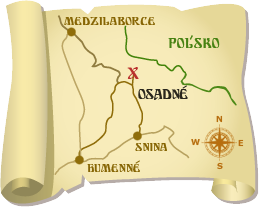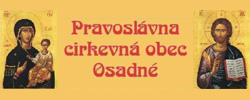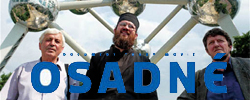The Crypt
The history of the crypt in Osadné is closely connected with the construction of Orthodox temple and with the circumstances related to revert of village inhabitants to the Orthodox Church in 1926. At its official founding (in 1543), the Ruthenian inhabitants of Telepovce (the name of Osadné until 1948) belonged to the Orthodox Church and even in 1612 there exist a written record about local orthodox clergyman. However, in 1726 the local clergyman Simeon Rusčanský signed the Union with Rome in Humenné, which was later incorrectly entitled as a Greek Catholic Church. After 200 years later (in 1926) all inhabitants of Osadné returned with their signatures in local register back to the religion of their ancestors - Orthodoxy like many other Ruthenian villages in the wider vicinity.
The construction of the temple and the crypt
All the events previously mentioned led to a decision of the Orthodox believers to build their own temple in 1926. The Lenik family donated a portion of their land to the church. Their donation enabled a temple to be constructed. To this day we pray for them. The approval for the construction wasn’t given, because the Orthodox Church wasn’t registered at that time in Osadné. The Orthodox Church was registered in 1929 with the Department of Education and Religion and assigned the registration number 33.121/IV/1929. Father Alexander was in agreement with the people for the necessity of providing a proper funeral for all the fallen Russian soldiers. The graves for those soldiers were scattered all around the land. The people wanted to pay respect to the dead. As a result, the people decided to build a crypt under the temple, where it would be possible to pray for them. Skeletons of the late Russians soldiers were found in the nearby forests, mainly in Udava, Skóry and some from a local war graveyard. As a result of their actions, a letter requesting the construction of a memorial could be written.
In 1928, a group called Jednota (Unity - Brotherhood), was established in Prague. The purpose of Jednota was to hold proper funerals for the Orthodox soldiers. The leader of the group was a Russian, Nadežda Kramářová, wife of the Prime Minister of Czechoslovakia. Certainly, therefore, the Czechoslovakian president T. G. Masaryk approved the request to build the temple. Not only did Masaryk provide the necessary approval for the temple’s construction, he supported it financially. The plaque identifying the crypt’s purpose of paying respect for the dead is written not only in Slovak but in Czech. The second part of the text is written in Russian, giving recognition to the efforts of Jedtota. On the 8th of October 1928, Jednota was permitted to publicly solicit fund raising for the construction of temples, chapels and graves for the deceased Russian soldiers in Czechoslovakia. The Medzilaborce-Telepovce collection raised 15,911 Slovak crowns, and the funds were used for the temple in Telepovce (Osadné). Construction of the crypt began in 1929. Archimandrit Andrej Kolomacký was the project’s architect. Pravoslavnaja Karpatskaja Rus, a newspaper provided the first written documentation of the project. The cornerstone was laid in 1928 according to the newspaper and blessed in 1930.
The attempt to bury soldiers began in 1920 with the exhumation of a large military cemetery in Osadné. The effort met with a serious problem. According to written reports of the local Gendarmerie (police) station in 1921, "... the military budget on exhumation of graves could not be presented because the local population does not want the exhumation and Gypsies are not in this district... The folks from Osadné refused to participate in the exhumations, arguing that: "... corpses have not yet rotten, and consequently the opening of graves will smell awful." The Provincial Military Command from Uzhgorod Ruthenia declined the help request as well. The task was undertaken by an enterpreneur Koloman Graubert of Starina. Not all of the tombs were transported to the cemetery.
We have not maintained statistics on the number of Russian soldiers exhumed at the military cemetery in Osadné. We have noted the number of Russian soldiers whose remains were placed in the crypt. Factual evidence states that bones were deposited into the crypt in the years 1933 – 1934. However, there was a crypt drawn in the architectual plans. The difficulty is to determine if some bones were transferred in 1928, or if there is only a room under the altar and later a pit with dimensions of 1,5 m x 4 m and a depth of 7 m (reportedly up to 11 meters). According to military records, 931 soldiers were exhumed from the military cemeteries of Osadne, Nižná and Vyšná Jablonka in 1933. The remains of 94 soldiers were exhumed from 13 - 17 November 1933 from scattered graves near Skóry (Pod kozím vrchom, Zadné Skóry, Poľana and Kozí Ortáš). Soldiers were placed into the crypt from the 3rd to the 23rd of October 1934. A tablet in Czech and Russian was placed into the crypt with a text: “1025 DEAD SOLDIERS FROM THE WORLD WAR 1914 – 1915 REST HERE. 23 KNOWN BY THE NAME 1002 UNKNOWN. GOD REST SOULS OF THE DEPARTED THY SERVANT." The list containing the names of the 23 Russian soldiers has been lost, now the names of all 1025 soldiers are unknown but unto God. Corpses of 1467 Austro-Hungarian soldiers from the cementaries in Osadné, Nižná and Vyšná Jablonka were stored in two enclosures on the grounds of the current cemetery near the Uniatic temple. A list containing the names of 63 fallen soldiers buried there was can be found.
Even the locals were involved in the exhumation of the soldiers. The recently deceased inhabitant of Osadné - Štefan Kimak, personally told us about the locals’involvement with the exhumation. Mr. Kimak along with others, participated in the collection of the bones from the forests. When people picked up some of the remnants from the ground, they could feel the flesh separate from the bone. "We were all afraid that we could have caught some kind of a disease from the flesh and that we won’t live for very long, but I am still alive. “ – he said. He died in the age of 92.
Reconstruction of the crypt
As the years passed, people forgot about the crypt. The floor was of concrete construction and used as a warehouse. Conservation organizations and tourists demonstrated a growing interest in the crypt. In cooperation with the Association of Friends of Eastern Carpathia, priest Mikuláš Petrovka managed to open a part of the crypt for public, As a result, tourists could enter the crypt and examine its contents. Priest Mikuláš Petrovka secured funds for a new door to the crypt.
Unfortunately, moisture was destroying the crypt and posibility existed that the ceiling would collapse. In 2002 priest Peter Soroka was appointed to Osadné and started contacting various institutions regarding the crypt. Either no response from elicited from those contacted or there was outright rejection. Priest Soroka contacted the Russian Embassy in Bratislava. In January 2003 the Russian Embassy First Secretary Oleg Semenov visited Osadné. Secretary Semenov promised financial aid for the reparation of the crypt. The crypt’s reparation was initiated in 2003. Lenik, a cooperation, was able to repair virtually the entire interior of the crypt by the end of 2003. The work performed encompassed reparation of the floor, walls, ceiling, and the introduction of electrical wiring. Work continued into 2004 with the building a shelter which served as an entrance to the crypt, and improved the drainage around the temple. A cross was raised in front of the crypt, which was blessed by Metropolitan Nikolaj on the 5th of September 2004. Metropolitan Nikolaj was the spiritual leader of the Orthodox Church in the Czech lands and Slovakia. The dedication was attended by representatives of the Russian embassy. in 2005, a walkway leading to the crypt was completed and the reparation project was finished. On July 17th, 2005, the crypt was dedicated by John, Bishop of Michalovce. Distinguished guests and representatives of the Office of the President, Ministry of Culture, the Parliament of the Slovak Republic, the Slovak Republic army, embassies, and more than 500 believers attended the event. Minister Lavrov expressed his gratitude to the priest and believers of the Parish of Orthodox church in Osadné for the care and work in the reconstruction of the crypt. Additionally, a letter from the Slovak President Ivan Gašparovič was read offering his greetings and best wishes. President Gašparovič met with the priest Soroka at a later date. The Embassy of the Russian Federation has given 1.3 million Slovak Crowns (43 152 €) for the reparation of the crypt. On the June 24th, 2010, the Russian Ambassador in Slovakia Pavel Kuznetsov accompanied by the Russian Federation, Honorary Consul of Slovakia Ladislav Štefko visited Osadné and it`s crypt.
Osadné has received 2000 € from the Austrian Black Cross. The gift is for the remains of soldiers from the Austro-Hungarian army as well.
Osadné today
Today Osadné is a small village populated mostly by senior citizens. As a result of the documentary, Osadné has became quite famous not only to people in Slovakia but also to people throughout the world. Tourism to Osadné has increased every year since the documentary was released. Visitors to Osadné not only visit our unique crypt, but enjoy our beautiful mountains around the village. Osadné has sponsored an International Festival for Slovaks and Polish, Nativity concerts, The Bethlehem play etc. The village continues to plan for the future and prays to the Lord for His help.



